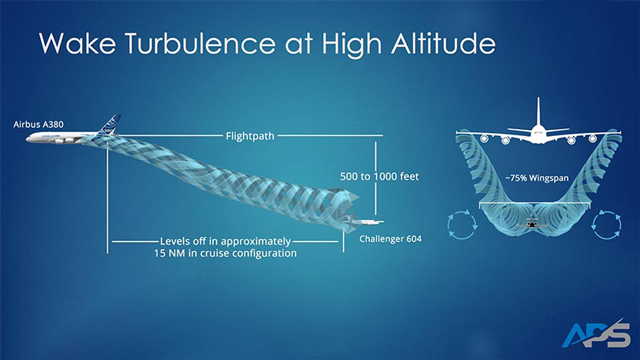The APS S211 is rapidly becoming one of APS’ most popular Upset Prevention and Recovery Training (UPRT) platforms.
Hypothetical Simulation of 2017 A380/Challenger Upset over the Arabian Sean
In January 2017, a Bombardier Challenger 604 was upset by an Airbus A380 causing a loss of nearly 10,000′ and enough structural damage to the Challenger to cause the Challenger to be removed from service. A synopsis of the A380-Challenger Wake Turbulence Encounter is available at the International Ops 2017 website.

In the above video, APS shows two situations:
- Hypothetical Wake Upset – APS shows one variation of what could cause an airplane to descend nearly 10,000′ in 30 – 45 seconds. This is NOT a statement or claim by APS that this initial scenario represents what really happened. Once the official report comes out, APS will link to that report here. In the video, note that there is a comment about ‘10,000 feet per minute rate of descent’. In reality, the rate of descent in this exercise touches approximately 16,000 fpm before the recovery is initiated. In this situation, the Garmin display stopped the rate of descent reading at a maximum of 9,999 fpm. Team onboard: Instructor Paul BJ Ransbury with Capt. David Ryan, the NBAA Safety Committee Chairman, participating as the test pilot in the rear seat.
- Effective High Altitude Wake Upset Recovery – The second portion of the video demonstrates a proper high altitude wake turbulence upset recovery flown by Capt. John Cox from Safety Operating Systems, a highly experienced airline Captain and former Executive Air Safety Vice-Chairman for ALPA. Team onboard: Instructor Paul BJ Ransbury, APS President with Capt. John Cox participating as the test pilot flying the recovery from the rear seat.
A few details:
- First Video Segment – Hypothetical Wake Upset
- The instructor initiates a high altitude wake encounter and then simulates an incorrect over response and spatial disorientation causing the S211 to complete several full rolls (similar to the actual A380/Challenger event) resulting in a steep dive angle, rapid airspeed gain, and overall loss of just over 9,000′ of altitude as was experienced in the real A380/Challenger wake turbulence encounter.
- Second Video Segment – Effective Wake Upset Recovery
- The test pilot, John Cox, takes the controls and disconnects the autopilot immediately after the instructor initiates the wake encounter simulation. Note the marked difference between an effective recovery and the first segement where the pilot inappropriately acts while being spatially disoriented. Both segments are approximately the same amount of time. The first dramatic and potentially devastating, whereas the second was controlled, measured and without drama.
Relevant articles:
- Aviation Week: In the Wake of an A380: Dealing with Wake Turbulence
- International Ops 2017: Enroute A380 wake flips Challenger 604 upside down
- Aviation Week: German Challenger Totaled After A380 Wake Turbulence
- Flying Magazine: Increased Lateral Separation Urged as A380’s Wake Flips Challenger 604




While the second recovery was significantly better than the first, the APS pilots know the upset is coming vs suddenly finding yourself inverted in the enroute route structure.
Hi John. Thank you for the comment. You are correct that APS instructors are aware of the maneuvers that are implemented in the program and have an active involvement in steering the training profile. However, for wake encouters such as shown in the second segement where the pilot is nearing the end of the 3-day Upset Prevention and Recovery Training (UPRT) program, the pilot in training in the rear seat (the pilot flying the second segment of the video) is not given any notice that the upset is going to occur, nor are they informed which type of upset is being presented. This training approach is essential to introducing starte and surprise factors into the UPRT program. Yet, startle can not be used indiscriminately and requires expert judgement on part of the instructor to determine when best to introduce no-notice unexpected UPRT events to progress, not regress, training.